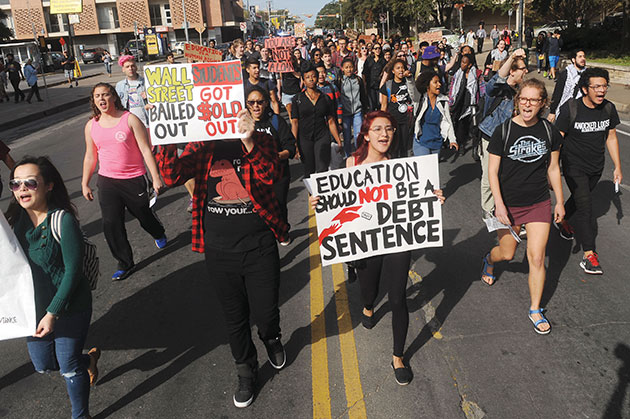Editor’s Letter: The Fees That Bind Us
Who pays for higher education in Texas?
Paying for college. The thought can strike fear into your financial planning as acutely as other heart-stopping expenses—I’m looking at you, health insurance, child care, retirement. Over the last decade, as college tuition costs have soared into the stratosphere, our collective apprehension about being able to afford one of the surest routes to professional success has risen right alongside. Just as a sort of dark game, my wife and I will sometimes make bets with one another about how much we expect our future children’s tuition to be. Twenty years from now, it’s anyone’s guess.
Who pays for college and how much are questions as old as the universities themselves. In the case of public institutions, like dear alma mater, the answer is at least partly in the name. But the days of the state picking up most or all of the tab are long gone. As demand for higher education has grown and the number of students going to college has increased, the state has not been able or willing to keep pace with the expenses of educating everyone on the public dime. Adjusted for inflation, state funding for UT-Austin has declined 42 percent since 1984.
Coming up as we are on a legislative session, the inevitable cawing and crowing has begun about who is to blame and what is to be done about rising tuition costs, or the roughly $1.3 trillion in student loan debt nationwide (mine’s in there). There are many alleged culprits: administrative salaries, professors who only do research, lavish spending on pools and dorms, and hidden taxes, to name a few. But a state-by-state analysis by FiveThirtyEight shows an almost one-to-one correlation between the rate at which states have disinvested from higher education and the rate of tuition increases.
Take Texas. From 2000 to 2014, average tuition has risen 3.2 percent. Meanwhile, per-student appropriations in inflation-adjusted dollars have fallen 3.9 percent, according to FiveThirtyEight. At UT-Austin, there is much uninformed wailing about the alleged effects of tuition deregulation, which happened in 2003. That was when it got bad, the thinking goes. But the facts don’t bear it out. From 1990-91 to 2002-03, when legislators set tuition, the rates rose on average 11.5 percent a year. Since deregulation, when the schols have set tuition, the rates have risen on average 5.5 percent per year.
We can disagree about what can or should be done moving forward, but only after we acknowledge the facts about how we arrived where we are. Lt. Gov. Dan Patrick believes that one feature of deregulation, called tuition set-asides, should be repealed. The policy, written into the 2003 law, mandated that 20 percent of any tuition increase be set aside to subsidize low-income students. Patrick believes this to be “a hidden tax” that disproportionately affects middle-class families, who could be borrowing money that is actually paying for part of other students’ tuition. Scrap the set-asides, and you can lower tuition by 20 percent, he says. It’s worth noting that it was Texas legislators who created the set-aside program (progressive though it is)—not the universities—and legislators did so because they slashed higher education spending.
In his state of the university address this September, President Greg Fenves observed that most students from families making less than $60,000 a year effectively pay no tuition, and attuned as he is to the political winds blowing, announced $15 million in new financial aid for middle-class students. These are fair and worthwhile topics for discussion, especially when based on a clear reading of the facts. But whatever we do, let us not lose sight of the central force propelling tuition rates up: There’s less and less “public” in public universities. That, more than anything else, is what should give us all heartburn.
Tim Taliaferro
Editor-in-Chief
Students and activists march around the University of Texas at Austin campus as part of a nationwide Million Student March on Nov. 12, 2015. Photo by John Anderson, Austin Chronicle.


















1 Comment